Ever since I started listening to my father’s old records, my enthusiasm for music started growing every day. First I was very interested in guitars, you know to fulfill my rockstar dreams, however, soon enough I started to feel the role and importance of the bass guitar in a band, and boy oh boy that groove.
I was very eager to have one at my hands and jam those bass lines and made my old man buy one, a Fender Precision Bass, I wasn’t sure what it was or its specifications and characteristics. Albeit being a great guitar, I think I could have done better if I bought one today, so I want to provide you a general guideline about some major things to look out, determine the type you want to buy, and certain characteristics that come from certain builds.
You’ll find plenty of articles on the internet, about how to buy a guitar, they are all excellent, but may feel a little overwhelming telling you all the differences between body shape types, the neck pockets, the finish, the coil types, and whatnot. Today I want to stick to the basics, as this article is aimed at beginners, but I think even experienced players can learn a thing or two.
The three most important factors when buying your first bass guitars would be the string number, frets, and the pickups. Of course I will give details about other things to look out for, however, this is the factors that will make or break your experience, so here we go.
Table of Contents
Top 10 Bass Guitars Of The Year
10. Squier Affinity PJ Bass
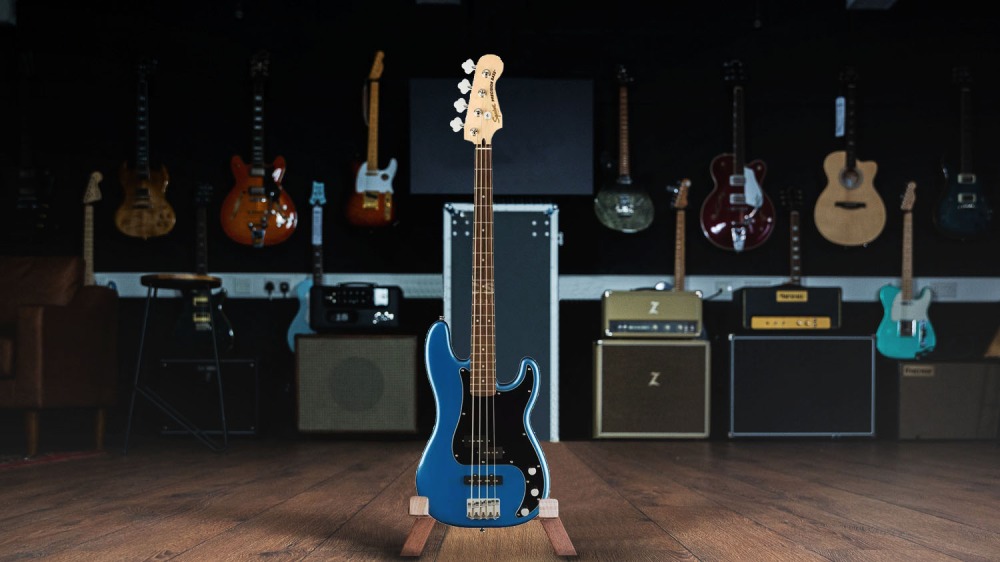
The Squier by Fender brand has created excellent beginner and entry-level instruments that are affordable, look good and provide good features. Since they are a subsidiary of Fender they have been able to copy the style of Fender models, that are very attractive to every player. The Squier Affinity PJ Bass has a perfect mix of quality and performance rounded out at an extremely affordable price.
Design and build wise it mimics Fender style shape, its body is made of alder wood and is available in different colors, the Black being my favorite of the bunch. It features a C shape neck with a maple design and a rosewood fretboard that houses jumbo frets. In terms of build quality, the Squier Affinity PJ Bass is remarkable and it doesn’t disappoint. It is also worth stating that the intonation of the guitar is great right from the get-go.
The Squier Affinity PJ Bass has a mediocre setup, with a decent bridge that has four adjustable saddles, on top of that it has a die-cast tuning machines that are pretty standard on the headstock. A good layout that should last you for a long time, if you don’t push them out of their limits.
Thanks to its Precision/Jazz nature, this bass guitar provides a decent amount of output and clarity due to the passive pups. It has a good range of controls for tonal shaping including two knobs for each pickup, that one is single-coil jazz and the other a split-coil precision, and a knob for master tone. These controls should prove to be excellent for beginners.
Most importantly the sound of the Squier Affinity PJ Bass is excellent providing a great tonal range to work with and it can get pretty deep if you need it, also it can provide good sharpness in a more high-range sound.
9. Epiphone EB-3

The Epiphone EB-3 is a modern-day recreation of the famous Gibson EB-3 that was an excellent bass that was used by great bass players such as Jack Bruce and Bill Wyman. It features a standard 34-inch scale, with the gorgeous classic design, and amazing rock tone, all this combined with the great price, it is a dream come true for classic rock fans.
The Epiphone EB-3 looks and feels like a solid bass, weighing in just under 4 kilograms it is still pretty lightweight. It rocks a mahogany body with a cherry red coating that looks perfect while carrying those vintage vibes thanks to the three-ply black scratchplate. The neck of this bass has a very narrow width but feels full and deep, having an appropriate 18mm string spacing to make it accessible even for beginners. The frets on the fretboard aren’t sharp and make transitioning very smooth and comfortable while still putting an emphasis on the retro/vintage look.
The bridge is rather large for my taste and it features old school volume and tone knobs. You can select one of the three positions for pickups and completing the setup is the nickel hardware. Everything is of high-quality when it comes to hardware and the knobs work all pretty well.
The Epiphone EB-3 has a dual pickup configuration, with a Sidewinder bridge pickup and a mini-humbucker, combined these two provide a wide range of tones you can play on. I didn’t expect this tonal range at the price point.
The sound of the Epiphone EB-3 is remarkable, featuring a deep bassy sound with great sustain and containing a lot of warmness and naturality thanks to its humbucker pickups. I especially liked the resonation of the mahogany and the playability of this instrument.
8. Fender Standard Precision Bass

The Fender Standard Precision Bass is an excellent bass guitar that was first produced in 1951, as the first guitar made by Fender. It is also my first bass guitar so I have a special and deep connection with it. It is very popular and it has the same design as the first model and it is as versatile as bass guitars get, you can jam to everything with it from jazz to funk to heavy metal. Also, I would like to state that it is the same guitar that Joe Dart of the Vulfpeck has recorded its most albums on.
The body of the Fender Standard P-bass is built with alder and is cut to look smaller and more rounded base of the body compared to the J-bass that looks slightly bigger. It has even contouring and is coated with polyester with a good range of color you can choose from and a 3-ply white pickguard, this all makes this bass pretty light and you can play it for hours. The neck is made with maple and has a C chape with 20 frets and 34-inch scale length it is excellent and very balanced.
Fender has not altered anything when it comes to pickups, this guitar still uses a split single-coil precision bass pickup, that provides a full and classic sound. Coupled with the hum-canceling that is placed on the center of the body for clean and sharp sounds. There is a 4-Saddle Standard Vintage-Style with Single Groove Saddles for keeping the strings attached and Open-Gead Tuners to keep them in tune, both sport chrome finishing.
This is still arguably one of the best bass guitars for beginners on the market and you cannot go wrong with it. Simply remarkable, Fender Standard Precision Bass.
7. Sterling by Music Man Ray4
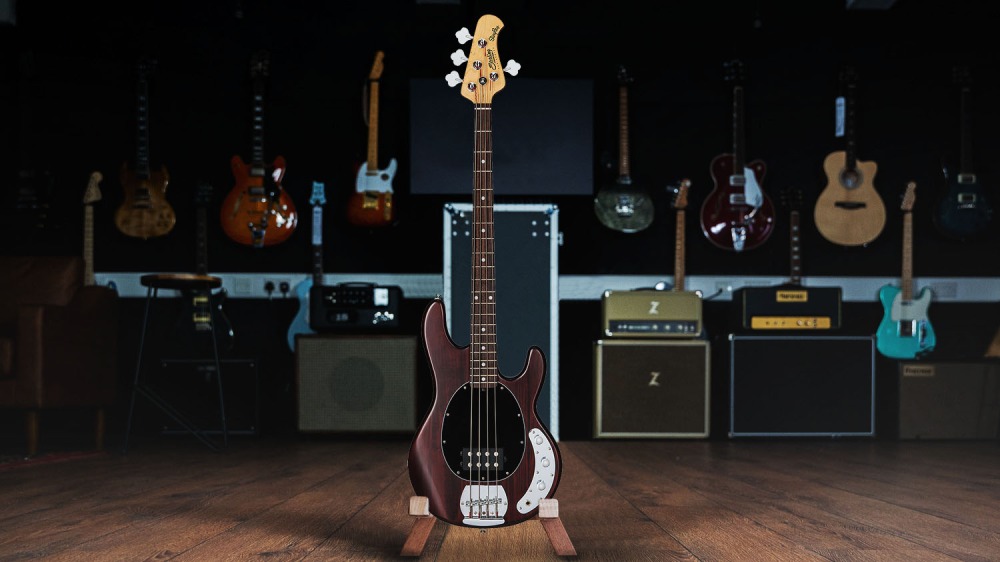
Sterling is a company that is licensed to produce affordable Music Man copies, so you may think that these are just cheap knock-offs. But you can’t be farther from the truth. Sterling bass guitars have never sacrificed quality and performance while keeping their prices low, and their Sterling by Music Man Ray4 is just perfect. It is an excellent bass for everyone, for advanced users, it offers great tone on a budget, and for beginners, it is a very future proof guitar.
This Sterling has the same shape as the Sting Ray that Music Man designed, hence the name. It is built with basswood that is an excellent choice an will prove itself even handier as you hone your techniques and skills. Hard maple is used on the neck of the guitar and the fretboard is also made from maple. Generally speaking the Sterling by Music Man Ray4 has a great build and is ready to play right out of the box, aside from tuning of course which may be off.
It is equipped with 4 adjustable saddles, and on the other side, you will spot standard die-cast tuning machines. The machine uses humbucker pickups that go hand to hand with an Active 2-band equalizer. This might give you the impression that it is limiting, but quite contrary it offers a lot of range.
The sound of the Sterling by Music Man Ray4 provides you amazing shaping options. I found that it was perfect for driving the rhythms I enjoyed playing my fav bass lines with different genres. Furthermore, it delivered great precision work with tons of definition.
Regardless, of your skill level or playing style, the Sterling by Music Man Ray4 will be one of the best bass guitars you have ever owned.
6. Schecter Omen 4
.jpg)
Schecter has worked their Guitar research center overtime in the last few years to fit in the competitive market. The results are remarkable as they have produced a good line of both guitar and bass guitar models. The Schecter Omen 4 is one of their best models, as it provides great build quality, amazing tone with plenty of range, and it sounds pretty neutral. It is one of the best choices for a beginner, but it is extremely capable.
The Schecter Omen 4 has a very generic bass body shape, typical to Schecter guitars. However, it is extremely comfortable to play on and as you can reach high notes without effort. This bass guitar utilizes high-quality mahogany tonewood that has a quilted maple top that feels excellent in terms of weight and substantiality. It uses maple on its neck and sports a rosewood fretboard with Pearloid vector inlays, combined with the C-shape, the Schecter Omen 4 is great for speedy players.
In terms of hardware, the Schecter Omen 4 uses its Diamond Bass model for its bridge design, the tuning machines are also pretty standard Schecter die-cast units. They all have black chrome color, and performance-wise offer perfect sustain and true intonation.
The biggest selling point of the Schecter Omen 4 is its pickups and active preamp.
Equipped with Schecter Diamond Bass pups that can provide you anything in terms of range, regardless of what you have in mind. You can easily shape the tone via the capable equalizer section.
When it comes to sound, I can guarantee you that this bass will be capable of playing every genre, and you will never feel that it is out of range. I particularly enjoyed playing heavy metal songs with it as it provided the aggressive drive that I like for the genre.
5. Fender Special Edition Deluxe PJ Bass
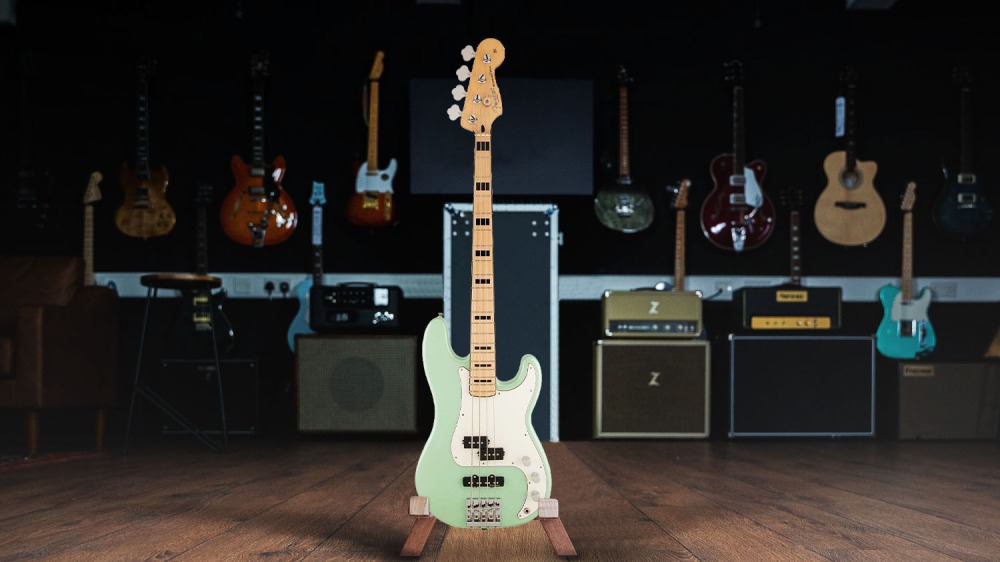
If you want your first or next bass guitar to be a special one, then the Fender Special Edition Deluxe PJ Bass is the most viable option. It is a very exclusive guitar with a Precision bass body that we know and love, coupled with the neck of a 70s Jazz bass. It is all made in Mexico and I guarantee you that it will turn heads, this one is a looker.
This bass guitar is excellently built, it has an alder tonewood precision bass body, as I mentioned earlier with a urethane finish. It comes in three colors, the 3-tone Sunburst Maple, Olympic White, and my personal favorite the Sea Form Pearl. The Fender Special Edition Deluxe PJ Bass features a maple 70s jazz neck also with a glossy urethane finish, coupled with a maple fingerboard sporting black block inlays. Furthermore, it has a standard 3-ply parchment pickguard.
Hardware-wise this bass is equipped with Fender high mass bass chrome bridge up top and standard open-gear tuning machines. Besides the combo body type, another major selling point of the Fender Special Edition Deluxe PJ Bass is the combination of excellent Precision and Jazz pickups to offer perfect sound.
The passive precision split single-coil neck pickup works in unison with the passive jazz bridge pickup, to deliver one of the smoothest jazz sounds you have ever heard. It offers a wide range of tones and gives you good control through its volume and tone knobs, a pretty versatile instrument.
It has a flat and neutral sound so you will find that it can play anything that you can and won’t feel out of the place. If you can afford its premium price, the Fender Special Edition Deluxe PJ Bass aims to be the last bass guitar you’ll own.
4. Ibanez GSR200
.jpg)
The Ibanez brand instantly reminds you of great guitars and bass guitars, that have impressive quality, amazing sound, but with a premium price tag. The Ibanez GSR200 is an exceptional bass guitar with great sound, remarkable build quality, but with an affordable price. It also has a nice set of features that will please even the most experienced bassist.
The Ibanez GSR200 is a full-body model made from agathis, clearly, they didn’t try to cut the costs to make it affordable. It has a 34-inch large scale rosewood fretboard that features chrome finishing, and I like its looks. The only part where the company has the cut the costs is at the control knobs, that are flimsy and can fall off easily, but you can replace them with knobs of your choice afterward.
The Ibanez GSR200 is equipped with a standard fixed bridge that features adjustable roller saddles, and a pretty standard set of die-cast tuning machines, which are perfect for a beginner bassist.
Interestingly enough the company has opted for an active set of electronics, with a split-coil pickup at the neck and a single-coil pickup at the bridge of the bass, a precision/jazz layout, except this one is active.
Right out-of-the-bat, this bass sounded pretty good, and it offered a lot of tonal shaping for its category. It sounded pretty warm and natural, with plenty of accuracies in the bass response. Of course, some experienced users may say that it is limiting, but it’ll be a while until you come to those.
With the Ibanez GSR200, you will increase your playing skills in no time thanks to its playability and tonal range. Also, it sounds very deep and thick for its price, so you will be also pleased with its sound.
3. Epiphone Thunderbird IV
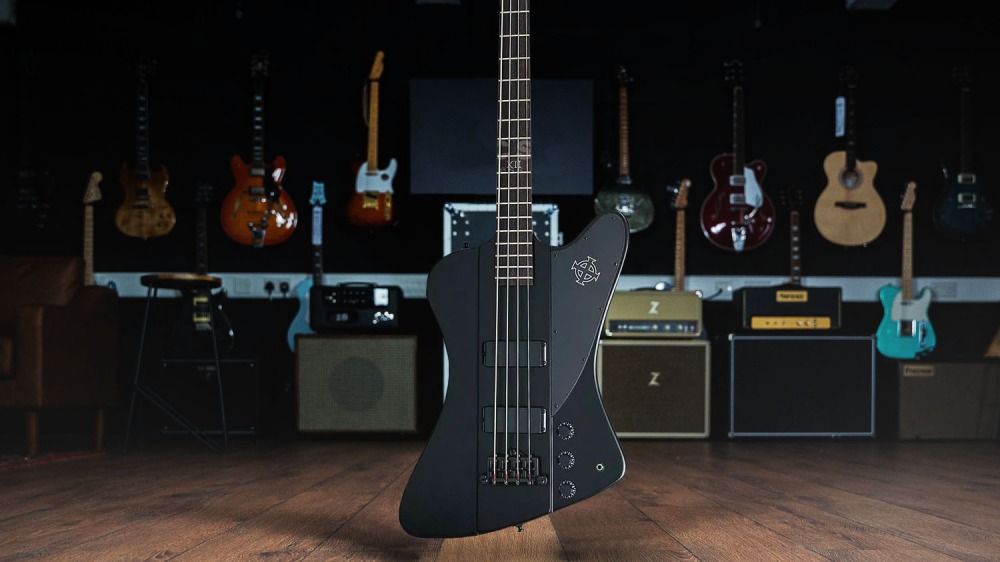
Epiphone has always spoiled their bass guitar buyers with excellent quality to price ratio. Their special edition Thunderbird IV is no exception, featuring the classic Thunderbird look with a great feel to it, the whole setup of the is marvelous, and I was very excited to play this bass guitar. Definitely one of the best in the market for every skill level.
The Epiphone Thunderbird IV sports a classic reversed body design with a medium weight alder tonewood. It really looks and feels perfect in the hand, it features a 34-inch maple neck with a rosewood fretboard. This fretboard invites you to dive deeper and practice new playing styles. Furthermore, if you play on a stage the Epiphone Thunderbird IV will get all the attention.
The Epiphone Thunderbird IV features exceptional sound control and decent tuners, it is equipped with two humbucker pickups and has a volume knob for each of them, also it has a knob shaping potentiometer to complete the controls. The controls work very well and allow you to customize the sound, for example, if you require or want a warmer sound just turn the middle pickups volume and bring down the bridge pickup, and vice versa for a sharper sound.
For this price range, the pickups are fabulous and will allow you to explore different sounds. I would like to state that the Epiphone Thunderbird IV was ready to rock right out of the box, it didn’t need any tuning or tweaking.
The sound from the Epiphone Thunderbird IV was really exceptional and that is mostly due to the EMG humbuckers, it was very punchy without being over the top a great balance overall. Versatile enough to jam in every genre, this bass guitar provides extreme value for its price, cherish it!
2. Yamaha TRBX 304
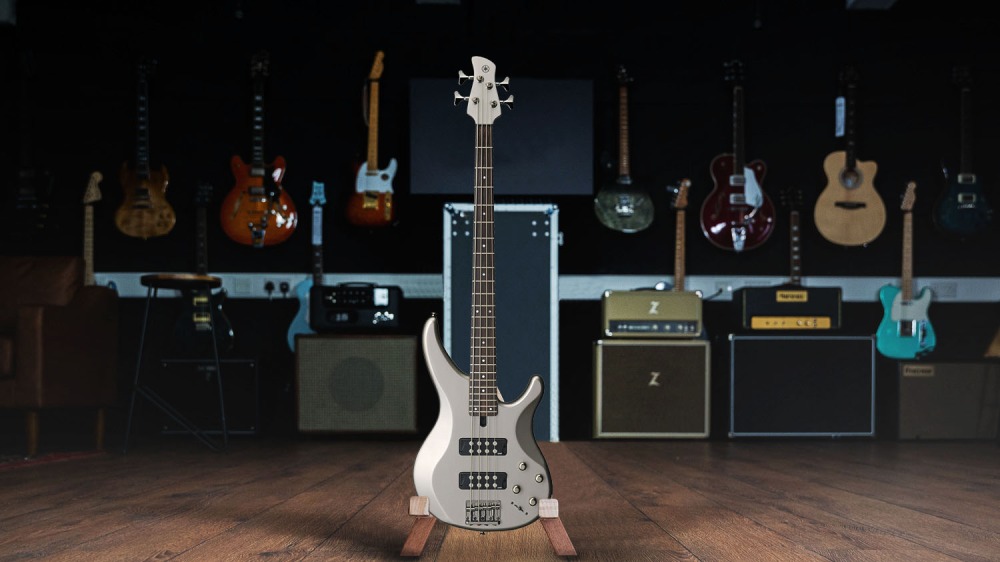
Yamaha’s TRBX line has been one of its best ones in recent years, it has amassed huge praise by critics and has been a great commercial success. The TRBX 304 maybe hasn’t any special features that make it stand out from the crowd, however, its core performance and quality build have put it in the same class with high-end basses, minus the price.
The Yamaha TRBX 304 has full mahogany tonewood body and its shape is very comfortable to hold and well balanced. You can choose from a variety of color schemes, my favorite being Tobacco Brown Sunburst. The neck of this bass is built with a combination of five-piece maple and mahogany, a feature that is exclusive to high-end basses. Furthermore, it has a 34-inch fretboard built from rosewood.
The bridge and tuning machines in this bass guitar are excellent, equipped with fully adjustable saddles on a vintage-style bridge and die-cast tuning machines. This combo will guarantee that you won’t be out of tune or lose intonation any time.
When it comes to pickups the Yamaha TRBX 304 is equipped with two M3 ceramic humbuckers that provide an amazing definition. To top that off it has four control knobs, plus a switch that selects presets that adjust two-bands EQ. It sounds pretty complicated but it is very intuitive when you try them.
The sound of the Yamaha TRBX 304 is just awesome, providing great depth with a wide range of tones that you can dial in, you will never outgrow this one. I strongly recommend this for beginners, because you will find that through the years this will push your limits and is a great learning experience.
The Yamaha TRBX 304 with its active electronics, performance EQ, and ultra-comfortable grip, is one of the best bass guitars on the market.
1. ESP LTD B-50
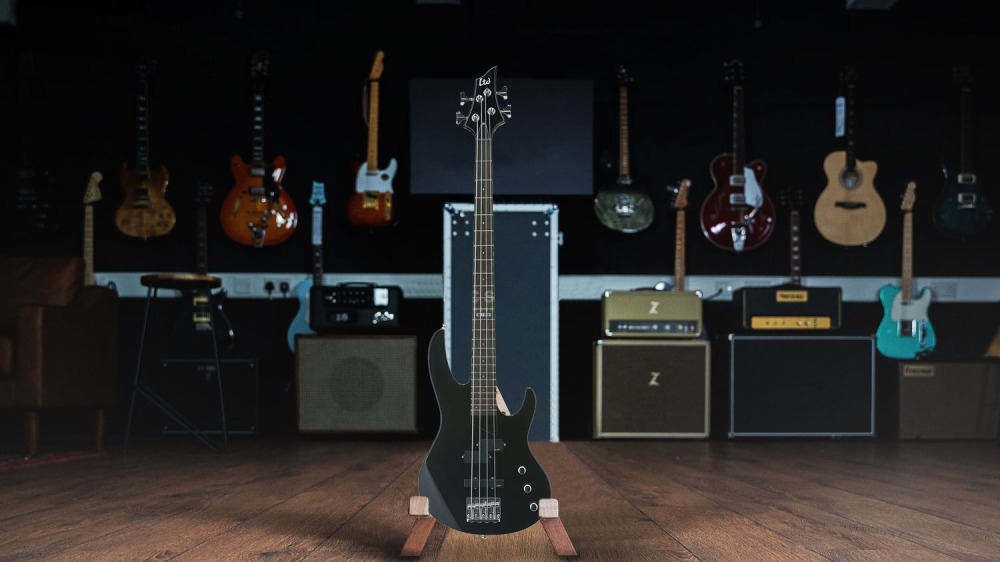
This one goes for the modern heavy rock player, it is simply designed with plenty of power, the ESP LTD B-50. This is in the budget-range of bass guitars however it is still one of the best bass guitars for beginners, because it is extremely playable and provides double the value its price would suggest.
This all-black ninja guitar uses double-cutaway body shape to allow perfect access to the higher frets. Its build features agathis, with a bolt-on maple neck. It features a 34-inch scale length, that is the standard and it is a very thin U-shaped one. The fretboard features 24 frets on its rosewood frame. I think this bass would fit in the hands of every player regardless of the genre and style.
The ESP LTD B-50 is equipped with great electronics that carry it onto another level. It is equipped with two passive ESP pickups, a precision split-coil at the neck and a jazz single-coil near the bridge area. It has three control knobs, two for the individual pickups and an active ATB-1 tone boost control, that is battery powered. It is also worth stating that the bridge and the tuners are all chrome and will prove their worth.
The sound of the ESP LTD B-50 is very versatile like its looks, it is capable of playing in any genre, funk, rock, pop, anything. I was particularly impressed with its heavy metal performance, that requires plenty of powerful drive and punch.
This bass guitar thanks to its active EQ control will boost the bass and treble directly from the guitar, without needing any accessory, which will prove very handy on the stage.
With the ESP LTD B-50, you definitely get twice what you pay for, an excellent bass guitar.
Things You Should Know About Bass Guitars
Strings Bass guitars generally come in 3 string flavors, 4, 5, and 6. You may think the more the strings the merrier, but it depends. For a beginner, I will always recommend a four-string bass, because it offers you everything you may need, and you really won’t outgrow this guitar. As you master your skills, of course, you may look into 5 or 6 string models, for playing intricate bass lines or solos. For a beginner you won’t need the extra strings, as you will make extraordinary progress just with those four strings, you will jam to your favorite songs, and can comfortably play in a band with one. So don’t stress it the time will come.
Fretboards – There are just two types of fretboard layouts, one is fretted and the other is fretless. The majority of bass guitars necks are fretted, meaning that they have steel frets along the fretboard, that differentiate notes. The fretless basses, as the name implies, don’t contain frets along the fretboard, this results in a warmer and a pretty smooth sound, however, they are very hard to learn on, as you’ll have to rely on your ear and muscle memory to play your part correctly. Unlike the fretted bass guitars, which encourage you to learn the notes, fingering positions, and discipline. This all means that fretted bass guitars are your best bet, for progressing faster.
Pickups – If you do not have any knowledge about the topic, simply speaking, pickups are a transducer that captures the string vibration through a magnetic field, from which the vibration turns into electrical current and then is outputted through the amplifier. A great number of bass guitars feature two sets of pickups to ensure a pretty wide tonal range you can play from. They generally are placed near to the fretboard or near the bridge, producing a smoother bassy sound and sharper high-end tones, respectively.
You will find single-coil and humbuckers in terms of types of them, and some variations of them if you dive deeper. Single-coils are the simplest of the two and the first to be produced, they have one coil and one magnet in each pickup to create a brighter more focused sound, that can get a little noisy, which led to the humbuckers. They were initially designed to eliminate the hum and noise created by single-coils, as the name would suggest. They provide a clean and fat bass sound, that can get a little muddy at higher volumes. You also can get a split-coil which combines to offer the best of both worlds, first used on the Fender Precision Bass.
String Length – Other than those you also must consider the string length, if you have shorter arms or a younger learner. As standard basses have a 34-inch string length, but you can find short scale basses if the standard ones are uncomfortable for you, having string length from 30 to 32-inches.
Tonewoods
You will also have to choose the type of wood the body of the bass is built from, as they will affect the sound and tone of your bass. There are 6 main bass body tonewoods, and I’ll give you some quick introduction to them.
- Alder delivers a very clear sound that is full and with balanced tonality.
- Ash is similar to alder providing sharp and full sounds, but have a different groove to them.
- Agathis offers a well-balanced tone that excels in the low and mid-range, and it is generally more affordable.
- Basswood is also very inexpensive and delivers a shorter sustain perfect for more complex playing styles.
- Mahogany is a little on the heavier side, but it features a soft and warm sound with enhanced low-range tones with amazing sustain.
- Maple is also heavy and produces remarkable sustain with sharp and clear tone, and is the preferred weapon of session guitarists.
Now let’s see some great examples of bass guitars that are listed in no particular order but all of them will provide you a remarkable experience.
Conclusion
This is it, my fellow bassists, this is a general guide that will help you decide to choose your first or even next bass guitar. But whatever you get to practice every day and never give up. I want to say that you also shouldn’t stress about your choice, the examples I have provided are all excellent options that you can’t go wrong with, but if your heart says that you should get something else, go ahead, you’ll do just fine, rock on buddy.










